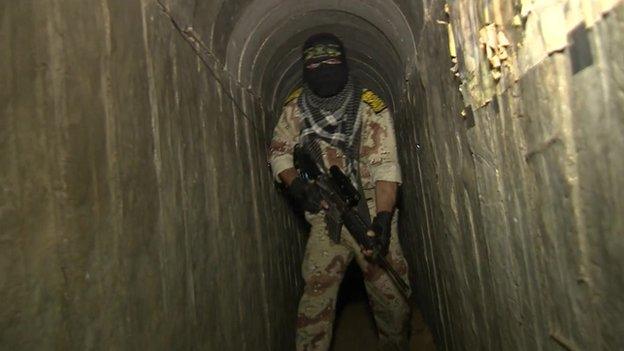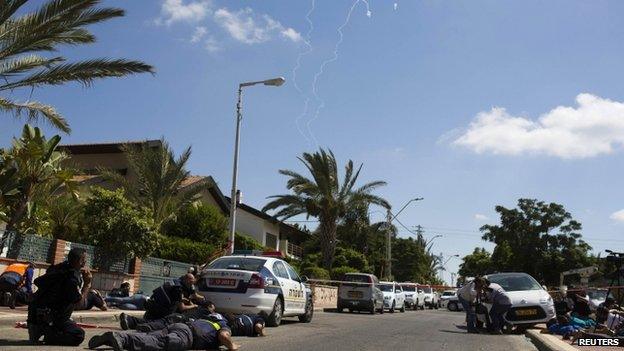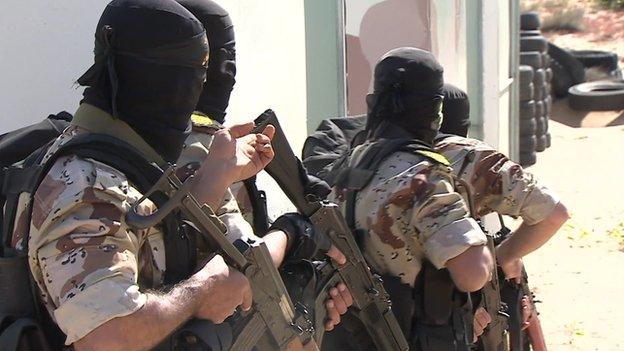Inside Gaza's tunnels, militants get ready for the next war
- Published

The Islamic Jihad group has concealed mortars underground to avoid detection by Israel
In an olive grove close to houses in the southern Gaza Strip, the earth slides open smoothly, revealing a sight to terrify Israel.
A deep pit containing a 120mm (4in) mortar tube, and three fighters from the militant group - Palestinian Islamic Jihad.
Fully armed and in combat fatigues, the men are all wearing head torches. They move quickly, in well-drilled movements, loading and unloading the tube from a stack of mortars at the back of their position.
This is a show of readiness, a show of strength, for the next war with Israel. It is a war that both the militants and the Israeli military, on the other side of the border, believe could come again soon.
The hidden mortar pit is right by the border with Israel, or so I am told.
I cannot be entirely sure as the armed fighters blindfolded me, searched me for tracking devices and removed my mobile phones before the journey.
Viewed as a terrorist group in the West, Islamic Jihad is committed to Israel's destruction.
(February 2015) Quentin Sommerville was blindfolded before gaining access to a Palestinian Islamic Jihad tunnel
At the back of the firing position is a small curtain that leads into a tunnel cut through the earth. It turns a corner and enters a larger, even deeper tunnel, perhaps 20m down.
Its reinforced concrete walls have an arched roof, tall enough for the men of Islamic Jihad to stand up, and run through it.
This is their escape route, running for hundreds of metres, its exit - or exits - unknown.
The well-constructed walls glisten as condensation reflects off the lights, powered by a car battery, that runs along the length of the tunnel. Deep underground, the air in the tunnel is cool.
Standing inside, his face hidden, is a fighter, with the nom de guerre, Abu Hamza.
"In the last war we noticed that every moving thing on the surface of the earth was bombed, whether it was ambulances, civilians or fighters walking on the street," he said.
"So [the tunnels] are our hiding place, away from the eyes of the Zionist enemy… we used them to launch [mortars and anti-tank] missiles".

Palestinian militants can move fast inside the tunnels
The tunnel was used in the last war, and it will be used in the next, he said.
As tensions - including attacks - continue between Hamas, who govern Gaza, and the Palestinian Authority, Islamic Jihad wants to make its presence felt.
The 50-day conflict in Gaza left at least 2,189 Palestinians dead, including more than 1,486 civilians, according to the UN, and 11,000 injured. On the Israeli side, 67 soldiers and six civilians were killed, with scores more wounded.
Large parts of neighbourhoods in Gaza are in ruins, and the Strip is in the midst of a humanitarian crisis which has left many thousands of families homeless.
Six months on, the rubble from the war lies mostly uncleared and there has been little rebuilding.
Israeli worries
In Israel, communities along the border are well drilled at responding to the rocket and mortar attacks. But they fear even more the tunnels that Hamas and Palestinian Islamic Jihad built under the border fence.

Last year's war was a battle between Israeli artillery and aircraft and militant mortars and rockets from Gaza
Some 32 tunnels were discovered crossing the border and there are believed to be hundreds more inside Gaza.
Israeli Prime Minister Benjamin Netanyahu has promised to eradicate the border tunnels but it seems that the threat, though reduced, still remains.
The war in Gaza took place in the skies - a battle between Israeli artillery and aircraft and militant mortars and rockets from Gaza.
But it was also an underground war. Israel was caught unprepared as the militants used tunnel warfare to an extent never seen before.
According to Col Dado, a commander of southern Gaza for the Israel Defense Forces, "the main goal of the tunnels is not to make peace - it is to go and attack civilians and to capture or kidnap soldiers.
"We are worried about it and trying to invent solutions to this problem."
He would not give details on how Israel is doing so. It is thought to be using enhanced scanning equipment to identify tunnel sites, which it then destroys.
'We stood our ground'
On Gaza's southern border, another battle is raging. Near daily explosions can be seen and heard as Egyptian forces extend a buffer zone with Gaza to a kilometre wide.
Egypt's soldiers move around in armoured vehicles. Border controls have been tightened and they are using explosives to destroy homes and smuggling tunnels that have been a lifeline to Gaza.
Egyptian President Abdul Fattah al-Sisi blames Hamas and others for aiding attacks in the Sinai.
Gaza is being cornered, more isolated than ever before. In Gaza City, demonstrators recently took to the streets to protest against Egyptian policies.
Publicly at least, Islamic Jihad refuses to acknowledge Egypt's role as hostile.
Abu Abdullah, another fighter, said, "we believe that Egypt's role in the conflict is as a… booster of the Palestinian cause".
But when I ask another militant when he thinks the next war will come, he jokes: "With Israel or with Egypt?"
And another war with Israel is inevitable, say the militants of Islamic Jihad. They say they lost 145 fighters during the last conflict. Many more civilians were killed. So what was achieved?
"Our biggest achievement is that we stood our ground, and we challenged the occupier," said Abu Ibrahim, a commander of their Saraya al-Quds brigade.
"Unlike the whole world, we are still able to say 'no' to them, 'no' to the occupation. We are still able to resist."

Islamic Jihad fighters have been training hard in recent days
Along the border with Israel, it remains relatively quiet. The six-month ceasefire is holding.
But Col Dado, like the men of Islamic Jihad on the other side of the fence, is pessimistic.
"We can see their side is [rebuilding] the tunnels and [preparing themselves] for the next fight," he said.
"We are doing the same. I hope it will be a long time from today, but I'm not pretty sure about it.
"So - sooner rather than later?" I ask.
"Unfortunately," the colonel responds.